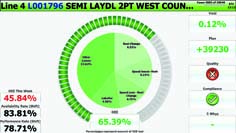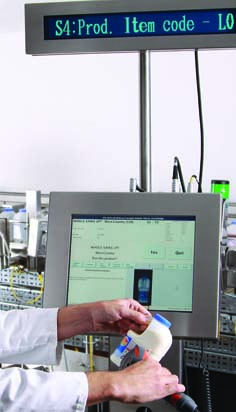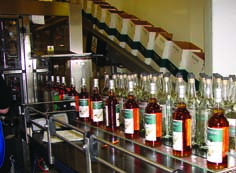World Class Lean Manufacturing – When OEE Is Not Enough
By Roy Green, Harford Control Ltd
 There is a lot of airtime given to World Class Lean Manufacturing, much of which might give the impression that it’s a whole lot easier than it really is – ‘Surely all you need to do is bring in the consultants or install an OEE system, or both, and the job’s done isn’t it?’
There is a lot of airtime given to World Class Lean Manufacturing, much of which might give the impression that it’s a whole lot easier than it really is – ‘Surely all you need to do is bring in the consultants or install an OEE system, or both, and the job’s done isn’t it?’
If only it were that simple everyone who has had the consultants in or bought a new OEE system would already be in the World Class Lean category. Sadly, whilst there is a lot of money spent in continuous improvement, OEE and TPM, evidence that such investments have led to sustained Lean Manufacturing can be hard to find.
The Valley of Death
Don’t get me wrong, I’m not knocking consultants or manufacturers of OEE systems. There are some really good consultants and some good OEE systems but so often the consultants do a great job whilst on site but, when they leave, the improvements are often not sustained and, at worst, drop into ‘The Valley of Death’ creating the need for yet more consultancy. We call this ‘consultancy dependence’.
Not All OEE Systems Are the Same
Similarly, not all OEE systems are the same. Most systems have some pretty impressive graphical displays but lack the granularity to drill down to the root cause, essential for performance improvement.
 Even the best OEE systems are not enough. Most companies now recognise, even if they are not yet using it, that OEE is a very useful world standard to drive performance improvement and some companies’ gains have been impressive, but generally speaking the actual gains fall a long way short of expectations. Why?
Even the best OEE systems are not enough. Most companies now recognise, even if they are not yet using it, that OEE is a very useful world standard to drive performance improvement and some companies’ gains have been impressive, but generally speaking the actual gains fall a long way short of expectations. Why?
As OEE percentage is derived from the multiplication of Availability, Performance and Quality metrics, it can be a force for good as a unifier, bringing together departments involved in purchasing, planning, production, quality and engineering. Though OEE has been around for more than 50 years, since its introduction by Seiichi Nakajima, it is still easy to fudge the end result making OEE look better than it is. For example: adding extra people to the line; artificially lowering the filler strike rate; leaving out product changeover or planned maintenance times; leaving out lunch and tea breaks; failing to include quality rejects or batch rejection. True OEE requires that all these be left in the calculations, simply because when taken out, there’s no incentive to reduce the omitted time periods.
OEE is Only One Metric
Even when done well, OEE is still only one composite metric, but it’s by no means a panacea as it does not include, for example, such vitally important metrics as labour or materials utilisation, both of which are essential for lean manufacturing.
After all, manufacturing is basically a conversion process whereby raw materials are delivered in order to make and dispatch consistently high quality products as quickly as possible. Though some of these processes might be quite simple, most are increasingly complex, especially within food and drink manufacturing, where producers are driven (often by supermarket demands) towards an increased product portfolio, total compliance, shorter batch runs, special offers, more frequent changeovers, short delivery times and tightly controlled delivery windows.
Failure to meet any one of these objectives can radically increase costs, cause batch rejection for non-compliance and even incur fines.
Retailer Price Wars
But supermarkets don’t want (can’t afford) to pay more for these increased demands, especially with the new round of price wars between the ‘big four’and the discounters. All manufacturers however will be only too aware that they are often forced to accept, higher prices for raw materials, energy usage and labour.
Inward Focus on Performance Improvement
So how can producers meet these demands and still show a profit or even increase profits? Through recognising that they have only two things that all their controls and improvements can affect: raw materials (including energy usage) and labour utilisation so, in addition to the much heralded OEE, they will need at least to report upon ‘units per man/hour produced’ ‘packs per litre/kilogram’, overfilling and overproduction; comparing these with predetermined target levels and even raising those targets from time to time.
 This can only be achieved through a more holistic inward focus geared to achieving total compliance but at reduced conversion cost, including; automated coding and labelling compliance, automated line set-up, automated short interval control, quality assurance, materials and labour utilisation, all in real time without paper, but still with instant visibility, analysis, prioritisation and distribution of information to those who most need it. Ease of traceability to prove due diligence on demand and for trending, is also important as unannounced audits are becoming increasingly commonplace. High visibility of current production status, integrated and automatically generated to maintain objectivity, is essential to drive and sustain consistently high performance.
This can only be achieved through a more holistic inward focus geared to achieving total compliance but at reduced conversion cost, including; automated coding and labelling compliance, automated line set-up, automated short interval control, quality assurance, materials and labour utilisation, all in real time without paper, but still with instant visibility, analysis, prioritisation and distribution of information to those who most need it. Ease of traceability to prove due diligence on demand and for trending, is also important as unannounced audits are becoming increasingly commonplace. High visibility of current production status, integrated and automatically generated to maintain objectivity, is essential to drive and sustain consistently high performance.
Many of our users have already increased profits, by significantly more than expected, through such internal focus and instant visibility, even without increasing sales turnover.
To find out more, and even arrange a free on site evaluation of how we could help you meet your objectives, call Harford Control on +44 (0)1225 764461.

































